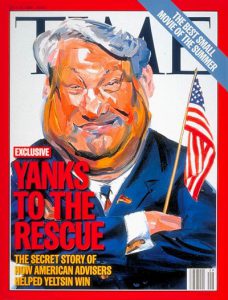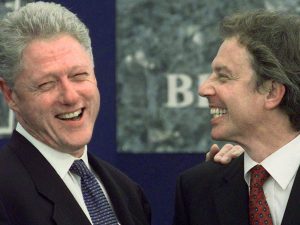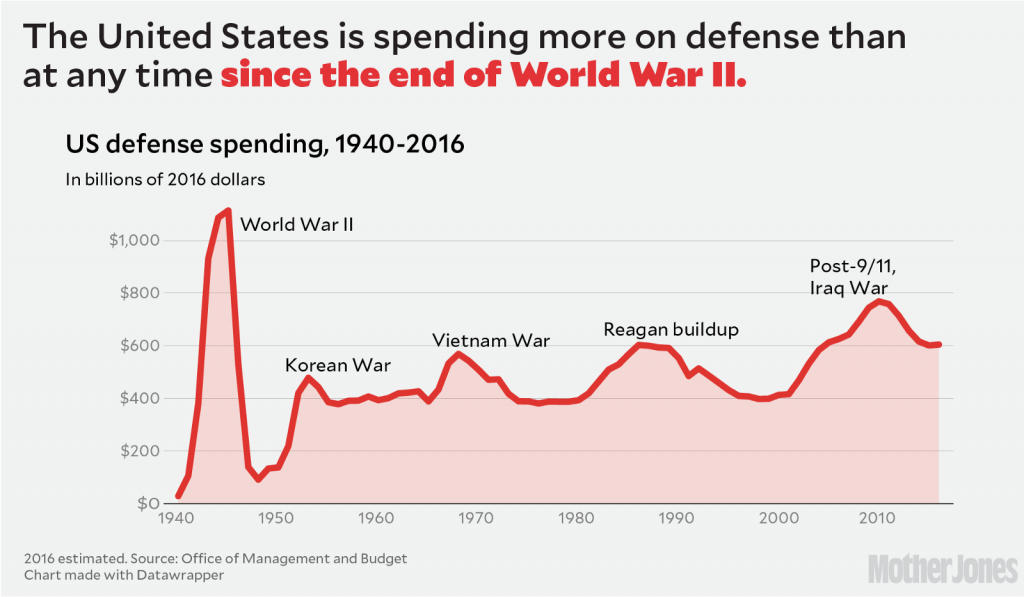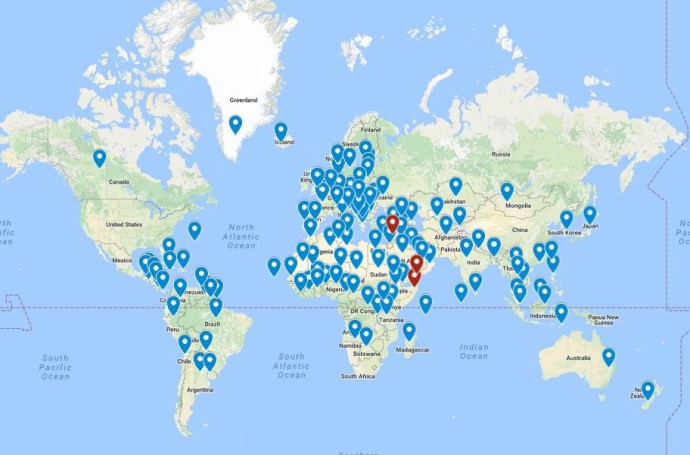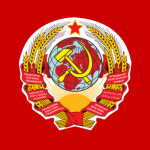 The “end of history” actually spelled the end of workers’ rights in the USA.
The “end of history” actually spelled the end of workers’ rights in the USA.
Part 1: A Little Revolution Can be Good
Franklin Delano Roosevelt is often credited with having “saved Capitalism in America”. Indeed, FDR even described himself as “the greatest friend the profit system ever had.” This is an obvious truth when taken in the historical context. When FDR took office, the country was in the midst of a deep depression which for many signalled the impending fall of Capitalism. Working people were being recruited in droves by a very active and vital American Communist Party as well as the American Socialist Party , and populist movements were sprouting up all over. In the face of these poplar uprisings, the American ruling class was (rightly) worried that the militancy caused by massive wealth inequality and worker exploitation that had toppled the Czar’s regime only a few years earlier could spread to the shores of the USA.
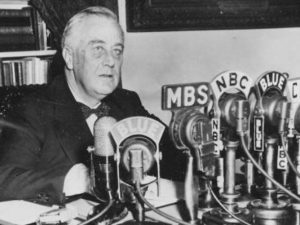 In response to the perceived threat, Roosevelt instituted the New Deal with all its worker protections and social programs, but perhaps his greatest achievement was to convince the American 1% (what he called the “Economic Royalists”) that if they wanted to keep what they had, they would need to share at least a little with the other 99%. Otherwise, they would see maddened hordes of impoverished Americans storming the gated communities in wealthy enclaves from the Hamptons to the Hollywood Hills.
In response to the perceived threat, Roosevelt instituted the New Deal with all its worker protections and social programs, but perhaps his greatest achievement was to convince the American 1% (what he called the “Economic Royalists”) that if they wanted to keep what they had, they would need to share at least a little with the other 99%. Otherwise, they would see maddened hordes of impoverished Americans storming the gated communities in wealthy enclaves from the Hamptons to the Hollywood Hills.
It can be argued, then, that had there been no November Revolution in Russia in 1917, there might not have been a New Deal in America 15 years later. And many forget that FDR was attacked repeatedly from the LEFT by grassroots populist movements led by the likes of Huey Long, Francis Townsend, Father Charles E. Coughlin and the radical Iowa Farm Union leader Milo Reno. There was revolution in the air back then, and many populists and workers’ advocates looked to the USSR as a model of what could be achieved. The balance that FDR had to strike between his capitalist cohorts and the populist workers’ movements was struck in an environment in which a worldwide socialist/communist movement, spearheaded by the Soviet Union, was a very real thing.
The Marshall Plan — Keeping Europe in the Capitalist System
The USA has often been praised for its cunning pragmatism in rebuilding Europe and Asia in the wake of WWII. The Marshall Plan saw thousands of American advisors “helping” Germany, Italy, Japan and others rebuild their countries into “thriving Democracies.” The Marshall Plan is often described in economic terms as a clever way for the US to create new markets for all its surplus production capacity, but there was also a very large political and economic component.
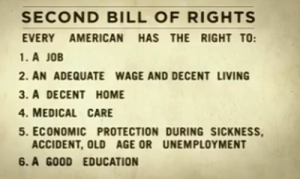 Indeed, the countries in Europe and Japan inserted into their new constitutions the main tenets of what FDR called his “Second Bill of Rights” — also known as the “Economic Bill of Rights.” This document stated that every citizen had the right to a decent housing, employment with dignity and a living wage, free health care, a generous pension and other “rights” that, ironically, Americans now associate more with Europe than with the New Deal. This is because FDR was unable to get his Second Bill of Rights passed by the Republican-controlled Congress. Nonetheless, his Administration, under the aegis of the Marshall Plan, was able to seed these basic principles abroad and they were eventually instituted in Europe and Japan.
Indeed, the countries in Europe and Japan inserted into their new constitutions the main tenets of what FDR called his “Second Bill of Rights” — also known as the “Economic Bill of Rights.” This document stated that every citizen had the right to a decent housing, employment with dignity and a living wage, free health care, a generous pension and other “rights” that, ironically, Americans now associate more with Europe than with the New Deal. This is because FDR was unable to get his Second Bill of Rights passed by the Republican-controlled Congress. Nonetheless, his Administration, under the aegis of the Marshall Plan, was able to seed these basic principles abroad and they were eventually instituted in Europe and Japan.
These Economic Rights were seen as necessary to stave off the threat of Soviet Communism, which was already being imposed in Eastern Europe and which was infiltrating Western Europe. Each major European country had an active Communist Party, and indeed one of the most blatant cases of the CIA “fixing” an election happened in 1948, when US Intelligence forces interfered to prevent a Communist from becoming Prime Minister of Italy. [Side note: this is why many Italians laugh when they hear Americans cry foul about so-called Russian “election meddling”].
Part 2: The Benefits of the Cold War
The Rise of the Military Industrial Complex
I am sure most of my readers are familiar with President Eisenhower’s address warning about the dangers posed by the Military Industrial Complex.
“In the councils of government, we must guard against the acquisition of unwarranted influence, whether sought or unsought, by the military industrial complex. The potential for the disastrous rise of misplaced power exists and will persist.”
The MIC was a major force in determining US foreign policy during the Cold War. But both America’s military and Corporate America were kept in check by a countervailing force: the USSR. The Soviet Union and the USA enjoyed a fairly stable relationship based on “mutual assured destruction” (MAD); a doctrine that was actually just a simple acknowledgment that any war between the two powers would lead to a “doomsday scenario” in which both sides would be incinerated in a massive nuclear exchange. Yes, there were tense episodes like the Cuban Missile Crisis. And yes, there was a sort of constant stress under the threat of MAD, evinced in the frequent “duck and cover” drills that young schoolchildren like me had to go through, and through various films like Failsafe and Dr. Strangelove. But by and large, the bipolar balance of power that existed under the Cold War remained relatively stable, if not exactly peaceful (Korea, Vietnam, Latin America, etc.).
The existence of the USSR gave the US a yardstick by which to measure its own dedication of resources to the military. The MIC was charged with ensuring that there was no “missile gap” — or indeed a gap in any area where the US might be behind the USSR in terms of military might. But by the same token, achieving parity or even superiority at least offered a sort of benchmark, a point at which Congress could say, “that is enough.”
Military adventurism was also held in check by the Soviets. Any move internationally had to be evaluated and even-tempered by the limitations imposed by “what the Soviets might do.”
The Civil Rights and the Peace Movements
It is not entirely coincidental that the Cold War period also saw some of the most major advances in social and economic justice take place in America. Racial inequality was a major propaganda tool used by the Soviets to portray America as a deeply divided and unequal society, and it must be acknowledged that LBJ’s Great Society was successful in part due to pressure imposed by social movements. It is now widely believed that the Black Panther Party and Stokely Carmichael had ties to the USSR.
In 1967, [Carmichael] went on a global speaking tour, giving speeches in Moscow, Havana and Hanoi, in which he condemned racism and capitalism alike. In the speeches he hinted at an impending race war in the United States, referring, most likely, to the arming of the Black Panthers.
That the Soviets would try to foment race war in the US is not in dispute; it should be also accepted, however, that the Civil Rights gains that took place in the late 60’s were partly due to that perceived influence and the sensitivity of the American ruling elite to the charges of American hypocrisy in preaching democracy and human rights abroad while denying them to large groups of people at home.
The BPP was not the only movement fueled by Sovietism. The Students for a Democratic Society (SDS), were increasingly militant:
While initially not sharply radical… by 1969 that was no longer the case. The group … had “evolved from civil rights struggles to an anti-Vietnam war stance to an advocacy of a militant anti-imperialist position.” (4) Correspondingly, it contained an array of different organizations vying for influence within it — from Trotskyists, anarchists and pro-Soviet communists, to Maoists.
SDS in turn gave rise in the early 1970’s to a campaign of bombings of US federal buildings across the country, conducted by the Weather Underground, a terrorist organisation that “rationalized militancy as the only recourse remaining to combat an unjust system.”
The thesis of Weatherman theory, as expounded in its founding document, You Don’t Need a Weatherman to Know Which Way the Wind Blows, was that “the main struggle going on in the world today is between U.S. imperialism and the national liberation struggles against it”,[26] based on Lenin’s theory of imperialism, first expounded in 1916 in Imperialism, the Highest Stage of Capitalism. In Weatherman theory “oppressed peoples” are the creators of the wealth of empire, “and it is to them that it belongs.” “The goal of revolutionary struggle must be the control and use of this wealth in the interest of the oppressed peoples of the world.” “The goal is the destruction of US imperialism and the achievement of a classless world: world communism”[27] — Wikipedia
Just as FDR saw the need to give the people economic progress in order to stave off a potential Soviet-style Communist revolution, so did LBJ and others see the need to to neutralise a growing militancy and calls for social revolution by passing Civil Rights laws and tamping down the overt militarism that had led to the Vietnam War.
Again, one needs to wonder: had there been no Soviet Union, no world power offering an alternative to US-style capitalism and imperialism, would the Civil Rights activists of the 60’s and 70’s have had the foundation and framework with which to organise their campaigns? Would LBJ and even Nixon have ever been forced — by a combination of shame, fear and pragmatism — to make concessions in terms of social and economic justice?
Part 3: The Fall of the USSR and the Rise of Hyper-capitalism and Hyper-Militarism
I am not going to discuss the socioeconomic disaster that befell Russia in the aftermath of the fall of the Soviet Union. But I will offer some background points to frame the effect that the collapse of the USSR had on America and the rest of the world.
“Yanks to the Rescue”
The fall of the Soviet Union offered Capitalists in the West — and especially the US — an amazing chance to make money. Transitioning from a Communist “command economy” to a capitalist “market economy” meant new opportunities for “economic cooperation.” And the US did everything it could to ensure that they had a willing partner in the Kremlin — that’s why they sent advisors to help Boris Yeltsin win the Presidency in 1994.
This overt election meddling by the US was seen in the West as a positive thing — a way to bring Russia into the capitalist / neoliberal fold. And it worked. Russia got all of the hard core crony capitalism and none of the pesky “watchdog” groups or legislation.
“The world is a business, Mr. Beale”
The West “won” the Cold War: Communist Russia was defeated, and the collapse of the USSR was seen not as the demise of a totalitarian power but as ideological proof that socialism and communism simply were not legitimate forms of statehood or society; that a truly egalitarian system without the profit motive and massive wealth inequality simply could not exist. Capitalism had WON.
And so the dogs of predatory Capitalism were let loose upon the world. The entire world became one big market. The fevered dreams of Ned Beatty’s character in Network became, at long last, a reality.
Gracious in Victory — NOT
Yes, the capitalist West “won” the Cold War. Yet, there was no Marshall Plan to help the vanquished enemy. Russia was pillaged and looted by the West — so much so that the life expectancy in Russia actually declined in the 90’s. The standard of living in Russia rapidly approached that of a third world nation. Just as significantly, the military might of the USSR was quickly dissipated, sold off, carved up and scattered across the international arms markets. Much of the Soviet ICBM arsenal was located in the Ukraine, which decommissioned and removed them (under Western supervision) once they became independent.
Perhaps the most significant event following the collapse of the USSR, both economically and symbolically, was the Reunification of Germany. East Germany was the industrial powerhouse of the USSR and the military linchpin of the Warsaw Pact. Allowing the German Democratic Republic (East) to become part of the Federal Republic of Germany (West) was a HUGE deal. Given that 27 million Russians had died fighting the Germans in WWII, you can only imagine the trepidation with which Gorbachev and the Russian military regarded the reconstitution of a large, powerful German State.
In direct bilateral talks with the Reagan and then Bush (41) Administrations, the US and Gorbachev agreed that if Russia allowed the peaceful reunification of Germany to proceed, NATO would not expand “one inch past Berlin.”
This made sense, as the Warsaw Pact — the Russian led military alliance that had faced off against NATO all during the Cold War — was dissolved in 1991, immediately following the withdrawal of East Germany as a result of the German Reunification in 1990.
Unfortunately, this agreement not to expand NATO Eastward was never codified into a written treaty, and the Americans broke the agreement as soon as Bill Clinton took office in 1992.
NATO Expansion over the years
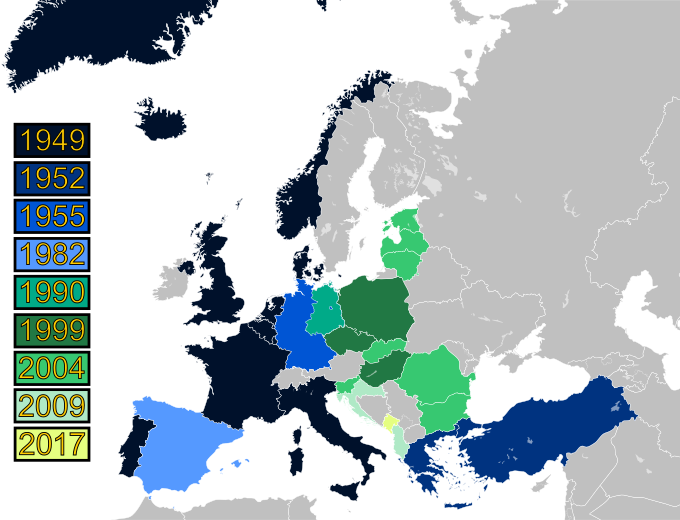 Clinton embarked on a program of NATO expansion, adding Poland, the Czech Republic and Hungary, and beginning talks with other potential members.
Clinton embarked on a program of NATO expansion, adding Poland, the Czech Republic and Hungary, and beginning talks with other potential members.
The result: since the fall of the Soviet Union, 13 new NATO members have added. These new members completely surround Russia’s borders from the Baltic States in the north to Georgia in the South. The expansion continues today, with the US pushing hard to get Ukraine not only into the EU but also into NATO. Indeed, the Russian annexation of Crimea is widely seen as a pre-emptive move so that the Russian Black Sea Fleet Base (one of the largest Russian military bases), which is located in Crimea, would not suddenly find itself inside of a NATO country. Such a scenario could have easily triggered WW3.
The mendacity of the West in dealing with post-Soviet Russia was, perhaps, to be expected. Clinton, and the US Presidents that followed him, all insisted on doing “victory laps” to cement US hegemony. As the “lone Superpower”, the US simply cannot resist “spiking the football” even today. This is, I suppose, a way of “dancing on the grave” of Communism, and it is something that every President has done since the fall of the USSR. The net effect of this geopolitical gloating, however, has been to make the world a very dangerous place.
Part 4: The Negative Effects of the Fall of the USSR on America and the World
I suppose it may still be difficult to see how the fall of the Soviet Union had a terrible and negative effect on the USA and the West. Here, then, is a brief summary and analysis of just how and why the disappearance of Soviet Communism from the global stage has negatively impacted the world and its peoples.
The Rise of Neoliberalism
It is no wonder, and certainly not a coincidence, that the fall of the Soviet Union fuelled the rise of Neoliberalism in the Western Democracies. Of course, Neoliberalism had been around for a long time — the movie Network referenced above was actually from 1976, long before the collapse of the USSR. But Neoliberalism, that is, the relentless pursuit of “market-based” solutions for society, had always been seen as a right-wing, reactionary concept.
Author’s note: If you are unfamiliar with what Neoliberalism actually is, I have written a primer to explain and define the concept:
Reagan Led the Way
Reaganism, such as it was practised, was the first beak-through in making Neoliberalism “mainstream”. Reagan said that Government was not the solution to the problem, but rather, Government was the problem. Only the Market and private enterprise could make people’s lives better and enrich society at all levels. Reagan’s famous quip regarding the ineptitude and even danger posed by the Government clearly illuminates the Neoliberal philosophy:
“The nine most terrifying words in the English language are, ‘I’m from the government and I’m here to help.’” — Ronald Reagan
This represented a complete break from the FDR New Deal philosophy in which Government was seen as a force for good, a way to help people.
Reagan and his form of neoliberal hyper-capitalism were credited with having “defeated” the Soviet Union and Communism. This proved a powerful counter argument to the attacks from the American Left, which wanted to preserve the economic safety net and the social compact that had been forged by the New Deal Democrats under FDR, Truman and LBJ.
Neoliberal Conservatives argued that because the US was so rich and powerful under Reagan, the Soviets collapsed because they could not “keep up” in terms of military spending. Reaganomics were working, they said, and they were making the world safe for democracy at last.
In reality, however, the fall of the USSR and the triumph of Reagan actually just made the world safe for unbridled capitalism and its resultant plutocracy. This was proven, unfortunately, by Reagan’s eventual successor, a self-proclaimed “New Democrat” named Bill Clinton.
Clinton, Blair and the “Third Way” of Neoliberalism
Bill Clinton and his counterpart, Prime Minister Tony Blair of the UK, were the first so-called “liberal” leaders to came to power in their countries after the fall of the Soviet Union and the resulting celebration and canonisation of their respective “conservative” predecessors, Ronald Reagan and Margaret Thatcher.
With the “fall of communism” as a backdrop, Clinton and Blair adopted the Neoliberal playbook of the Reagan/Thatcher era and gave it a thin veneer of “liberal” dogma in the areas of diversity, human rights and social justice. They paid lip service to supporting Labor, even as they worked to undermine unions and the working class. They called their new paradigm the “Third Way” and called themselves “New Democrats” in the US and “New Labour” in the UK.
The New Democrats were represented in the US by the Democratic Leadership Council, a pro-corporatist arm of the Party that drew its power from a base comprised of Corporate America and Wall Street. Indeed, when Bill Clinton was Chair of the DLC, its Executive Board was made up of representatives from 28 corporations, including the Koch Brothers.
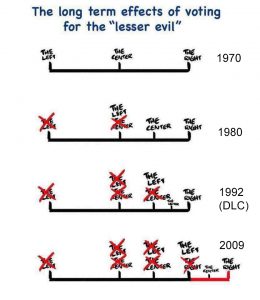 It was during this time that the Democrats and the Labour Party turned decidedly away from their working class base, in favour of big corporate and financial interests. After all, the Soviet Union was gone, international Communism was no longer a threat, and global capitalism was now the undisputed “winning side” in the great struggle between workers and owners, between wage earners and Management. Money was now everything, and making money was the only thing that mattered. A person’s worth could now be determined not by any intrinsic values, but by what “price” they could fetch in the Marketplace (what they now called the “Job Market”).
It was during this time that the Democrats and the Labour Party turned decidedly away from their working class base, in favour of big corporate and financial interests. After all, the Soviet Union was gone, international Communism was no longer a threat, and global capitalism was now the undisputed “winning side” in the great struggle between workers and owners, between wage earners and Management. Money was now everything, and making money was the only thing that mattered. A person’s worth could now be determined not by any intrinsic values, but by what “price” they could fetch in the Marketplace (what they now called the “Job Market”).
This is how the Democratic Party became the party of white-collar professionals and the educated elites, as Thomas Frank so masterfully described in his seminal books, What’s the Matter with Kansas and Listen, Liberal. According to the new, DLC-driven Democratic Party, Neoliberal globalisation and job-killing trade deals like NAFTA and the TPP were fine, people just needed to have the right education and societal status in order to thrive in the new “global economy’. There was no longer a place for the Trade Unionist Movement in the new Democratic Party. Indeed, manufacturing was seen as “old technology” and was no longer the way of the future. Under the new, Neoliberal regime, America was no longer in the business of making things. Except, of course, when it came to WAR.
Peace Dividend? What Peace Dividend?
There was a brief moment in time when people actually believed that the end of the Cold War would deliver a “Peace Dividend” to the American people in the form of renewed and increased investment in non-military development and government expenditures.
Sadly, this was not to be.
It has become painfully obvious to any rational observer that the Military Industrial Complex that Eisenhower warned about was not ready to curtail its activities — and profits — simply because the US no longer faced a global threat from international communism in the form of the USSR. No, they found plenty of other ways to keep America on a war footing, finally settling on an undefined and interminable “War on Terror”. This is actually better than the Cold War, because now there is not a single, physical, definable enemy like the Soviet Union. Now there is an enemy that is a concept, a vague, nebulous idea that can be defined in whatever way the US arms industry and the Pentagon wish to do so. The world is their oyster.
Without a Soviet Union to push back on US hegemony, the US military has expanded to encompass almost the entire world. The US currently maintains over 1000 bases, with active duty special forces and other military personnel serving in 138 countries. It is obscene.
The Congress just recently approved a massive increase to the Defense Budget of $80 billion a year. This is far and above what the Pentagon or even the Trump administration had requested. Worse yet, 60% of Democrats voted for this bill.
Final Part: How the fall of the USSR killed the Democratic Party
For me, as a lifelong Democrat, perhaps the most appalling result of the fall of the USSR was the fact that it led to the destruction of the Democratic Party.
Now, when I say Democratic Party, I mean the electoral powerhouse that was built under FDR; the Party that had a total lock on the Congress for 70+ years. The party that represented the vast majority of Americans: working people, the middle class, and yes, liberals and progressives.
Without the USSR there would have been no New Deal
As I mentioned above, FDR’s greatest achievement — according to the man himself — was that he saved Capitalism in America. I also explained that he had to convince those of his own privileged class (the 1%) to share some of the wealth with working people. But he could only make that case by scaring them with the terrifying spectre of a Communist revolution in America; of the progressive populists, farmers and factory workers, joining up to seize control of the country from those “Economic Royalists”.
But FDR could only make that threat credible because there was an example to point to: RUSSIA. What had befallen the Romanoffs and the Russian aristocracy could also happen to the Vanderbilts, the Pierponts, the Morgans, the Hearsts and yes, the Roosevelts.
But, FDR had to convince the 99% to go along with his plan as well.
The official name of almost every Communist or Socialist Party contained some variation of the word “worker”. Roosevelt, in his New Deal, had to convince the workers in America that their needs would be met, their views heard, their grievances addressed, not by the increasingly popular communist, socialist or radical progressive parties, but rather by the solid, traditional Democratic Party. Under FDR’s guidance, the Democrats became that party for working people.
Americans bought FDR’s argument; they saw the New Deal legislation take hold; they came to appreciate the new, worker-oriented institutions that were created to make life better for the working class. The move towards Communism was thwarted and Capitalism in America was indeed saved.
Once the USSR was gone, the New Deal came under attack – by Democrats
When the Soviet Union went away, so too did the need to keep the American working class satisfied. They had been lulled into a sense of well-being as the New Deal and the Post-WWII boom made the US the envy of the world. Wages increased, single worker households did well; blue-collar and white-collar workers were about on par, money wise, thanks to unions. The American Way of Life could be safely and effectively compared with that of the USSR because workers in America had it so good.
The trouble started when there was no longer a need to make that comparison.
Once capitalism had won, and the global economy was declared, the American worker became just another asset, a cost factor to be compared with workers elsewhere. Management determined what workers should be paid. And if the workers wanted too much, then Management could just move to a cheaper country.
In the late 1990’s, at the height of Bill Clinton’s Neoliberal restructuring of the American economy, Jack Welch, the iconic CEO of GE, famously said:
“Ideally, you’d have every plant you own on a barge.”
This quote, and its associated fame, shows just how far America has fallen in terms of respect for workers. There is none. So-called “Right to Work” legislation is spreading across the country, making it impossible for workers to form unions, to negotiate for their wages — to have a say in their own lives. And if they try to take a stand, then Management simply threatens to shut down and move to a low-wage country. It is a global “race to the bottom” that would probably not succeed if there were still a USSR acting as a global player and promulgating the idea of the ascendance, the elevation of workers in society.
The Democratic Party lumbered along for 30 years in their Neoliberal fashion, led by the corrupt DLC of Bill Clinton and Barack Obama, spurning workers, ignoring labor and unions, knowing that the working class had nowhere else to go. This lasted up until 2016, when workers, in desperation, turned to Donald Trump, if only to prove that they did, after all, have somewhere else to go.
EuroYankee is a dual citizen, US-EU. He travels around Europe, writing on politics, culture and such. He pays his US taxes so he gets to weigh in on what is happening in the States.

